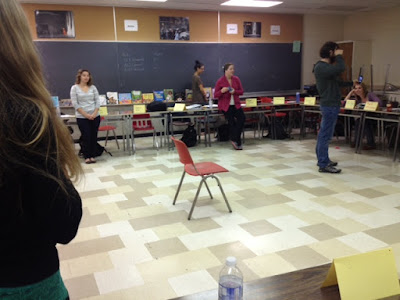Each week we were introduced to a variety of different
strategies to use in the classroom. For each week, I have stated which ones
were introduced and which one was my personal favourite. All of these
strategies are excellent and can be modified to use in any classroom!
Week 1: Position Mapping, Tableaux, Tap In, Living
Venn Diagram
Week 2: Alter-Ego, Teacher in Role, Gibberish,
Graffitti
Week 3: Picture Walk, Side Coaching, Soundscape,
Flashback, Role on the Wall
Week 5: Kamishibai, What If, Hot Seat, Caption Making,
Eavesdrop, Shadow Puppets, Slow Motion
Position Mapping
This was the first strategy we were
introduced to, and I think it’s a great drama strategy. In this strategy, you
use an object to represent something – in our case we used a chair to represent
drama. The entire class had to position themselves in relation to the chair
representing their comfort level with drama. This can be used for any subject
as a diagnostic tool to see where students are at, and where they may need
help. Not to mention, it allows students to see how the rest of the class feels
about the same topic. If I see that the rest of my friends aren’t comfortable,
it instantly makes it easier for me because we are all in the same boat!
Gibberish
This strategy was probably my favourite of
all – it encouraged creativity! In essence, we would read a book and have story
line. We were encouraged to change the story and adding a unique twist. Two
students would talk in Gibberish to one another, while others translate the
story. It gave us an opportunity to to be creative and have a great time doing
it. The sky is the limit with this strategy. It really allows the teacher to
gain insight on specific problem solving, critical thinking, and story telling
skills. If someone is uncomfortable creating a storyline by translating the
gibberish, they can speak the gibberish and act it out!
Soundscape
This was another one of my favourites. It
really allowed us to focus on the elements of choral work in drama. Once again,
this strategy encouraged creativity. In class we read a book called “Ladybug
Garden.” After the completion of the book, we were encouraged to brainstorm
sounds and noises that were happening in the pictures. In sync, we created vocals
to the sound of the garden in the story. You were free in your choice. I chose
to be a bee buzzing around the garden. The buzz would get louder as I was
closer, but fade in and out. Everyone is involved in this strategy at the same
time, nobody is singled out. If students are uncomfortable, they can make a quieter
noise or join in with their peers!
In the final week, my favourite strategy
was caption making. As we read through the story, each group was assigned a
specific, and important part of the storyline. The story was from an outside
perspective of the caterpillar. Caption making allowed us to create captions
for how the caterpillar was feeling at each stage of the story. Once the captions
are created, groups are encouraged to share their thoughts and act them out!
All of these strategies have certain
things in common – the encourage creativity and differentiate for multiple
learners. These are certainly valued in my opinion and will be the pedagogy
that represents myself as a teacher. My future classroom will rely on these two
common themes in everything that has to do with learning. All of these
strategies are effective because they are simple, easy to understand and can be
combined with a wide variety of other strategies to make drama fun.



No comments:
Post a Comment